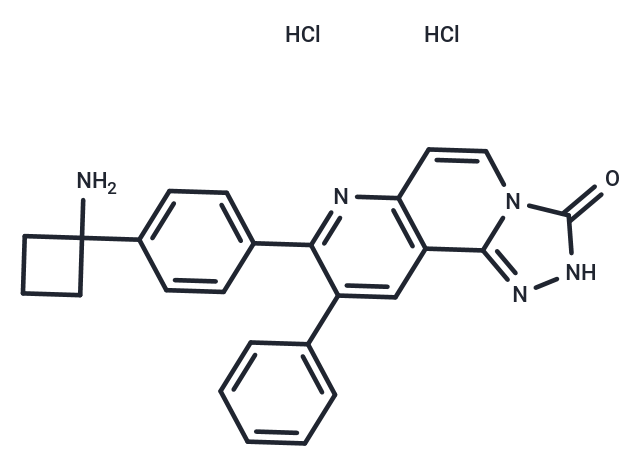购物车
- 全部删除
 您的购物车当前为空
您的购物车当前为空

MK-2206 dihydrochloride (MK-2206 2HCl) 是一种变构 Akt 抑制剂,抑制 Akt1、Akt2 和 Akt3 (IC50=8/12/65 nM),具有口服活性的、高效选择性。MK-2206 dihydrochloride 具有抗肿瘤活性。

MK-2206 dihydrochloride (MK-2206 2HCl) 是一种变构 Akt 抑制剂,抑制 Akt1、Akt2 和 Akt3 (IC50=8/12/65 nM),具有口服活性的、高效选择性。MK-2206 dihydrochloride 具有抗肿瘤活性。
| 规格 | 价格 | 库存 | 数量 |
|---|---|---|---|
| 1 mg | ¥ 298 | 现货 | |
| 2 mg | ¥ 428 | 现货 | |
| 5 mg | ¥ 689 | 现货 | |
| 10 mg | ¥ 969 | 现货 | |
| 25 mg | ¥ 1,620 | 现货 | |
| 50 mg | ¥ 2,380 | 现货 | |
| 100 mg | ¥ 3,380 | 现货 | |
| 200 mg | ¥ 4,830 | 现货 | |
| 500 mg | ¥ 7,380 | 现货 | |
| 1 mL x 10 mM (in DMSO) | ¥ 773 | 现货 |
| 产品描述 | MK-2206 dihydrochloride (MK-2206 2HCl) is a variant Akt inhibitor that inhibits Akt1, Akt2, and Akt3 (IC50=8/12/65 nM) with orally active, highly potent and selective potency. MK-2206 dihydrochloride exhibits antitumor activity. |
| 靶点活性 | Akt3:65 nM (cell free), Akt2:12 nM (cell free), Akt1:8 nM (cell free) |
| 体外活性 | 方法:14 种肿瘤细胞用 MK-2206 dihydrochloride 处理 72 h,使用 CellTiter-Glo assay 检测细胞活力。 结果:MK-2206 dihydrochloride 抑制肿瘤细胞生长,IC50 在 0.1-28.6 μmol/L之间。[1] 方法:人鼻咽癌细胞系 CNE-2、HONE-1 用 MK-2206 dihydrochloride (0.625-10 μM) 处理 24-48 h,使用 Flow Cytometry 方法检测细胞周期情况。 结果:MK-2206 dihydrochloride 导致 G0/G1 期细胞百分比的剂量依赖性增加和 S 期细胞数量的减少。MK-2206 dihydrochloride 诱导细胞周期停滞于 G1 期。[2] |
| 体内活性 | 方法:为检测体内抗肿瘤活性,将 MK-2206 dihydrochloride (120 mg/kg 每周三次或 360 mg/kg 每周一次,30% Captisol) 和 erlotinib (50 mg/kg 每周五次,0.5% methylcellulose + 0.1% Tween 80) 口服给药给携带人肺癌肿瘤 NCI-H292 的 CD1 小鼠,持续两周。 结果:每周三次的 MK-2206 单药治疗无效,每周一次的方案仅介导中等的抗肿瘤疗效。尽管 erlotinib 单独介导了显著的肿瘤生长抑制,但与 MK-2206 的联合治疗显著增强了其抗肿瘤疗效,包括肿瘤消退。[1] 方法:为检测体内抗肿瘤活性,将 MK-2206 dihydrochloride (120 mg/kg in 30% captisol) 灌胃给药给携带人子宫内膜癌肿瘤的 NSG 小鼠,每周两次,持续三周。 结果:MK-2206 dihydrochloride 治疗使 3 种不同类型和等级的 PDX 肿瘤的生长都受到显著抑制。[3] |
| 细胞实验 | Cells were seeded at a density of 2 to 3 × 103 per well in 96-well plates. Twenty-four hours after plating, varying concentrations of the drug, either as a single agent or in combination, were added to the wells. Cell proliferation was determined by using the CellTiter-Glo assay at 72 or 96 hours after dosing. The nature of the drug interaction was evaluated by using the combination index (CI) according to the method of Chou and Talalay. A commercial software package was obtained from Calcusyn. In combination with docetaxel, we tested three treatment sequences: (a) MK-2206 followed by docetaxel—cells were exposed to MK-2206 for 24 hours, and then after washout of MK-2206, cells were treated with docetaxel for an additional 72 hours; (b) docetaxel followed by MK-2206—cells were exposed to docetaxel for 24 hours, and then after washout of docetaxel, cells were treated with MK-2206 for an additional 72 hours; and (c) concurrent treatment—cells were exposed to both MK-2206 and docetaxel for 72 hours [2]. |
| 动物实验 | When the mean tumor size reached 0.13 cm3 for the SK-OV-3 or 0.2 cm3 for the NCI-H292, HCC70, PC-3, and NCI-H460 models, the mice were randomized into control and treatment groups with approximately equivalent ranges of tumor volume between groups (n = 5 animals per group). The following vehicles were used to dose the compounds: 30% Captisol (Cydex) for MK-2206; 0.5% methylcellulose + 0.1% Tween 80 for erlotinib; distilled water for lapatinib; 0.73% ethanol in saline for docetaxel; and saline for carboplatin and gemcitabine. The control group received vehicle only. Tumor volume was measured with calipers twice a week. Animal body weight and physical signs were monitored during the experiments. Tumor volume was calculated, taking length to be the longest diameter across the tumor and width to be the perpendicular diameter, by using the following formula: (length × width)2 × 0.5. Relative tumor volume was assessed by dividing the tumor volume on different observation days with the starting tumor volume. Statistical significance was evaluated by using the two-way repeated ANOVA test followed by Dunnett's test or an unpaired t-test [2]. |
| 别名 | MK-2206 2HCl |
| 分子量 | 480.39 |
| 分子式 | C25H23Cl2N5O |
| CAS No. | 1032350-13-2 |
| Smiles | Cl.Cl.NC1(CCC1)c1ccc(cc1)-c1nc2ccn3c(n[nH]c3=O)c2cc1-c1ccccc1 |
| 密度 | no data available |
| 存储 | Powder: -20°C for 3 years | In solvent: -80°C for 1 year | Shipping with blue ice. | |||||||||||||||||||||||||
| 溶解度信息 | Ethanol: < 1 mg/mL (insoluble or slightly soluble) DMSO: 7.5 mg/mL (15.61 mM) 10% DMSO+90% Saline: 0.75 mg/mL (1.56 mM), In vivo: Please add co-solvents sequentially, clarifying the solution as much as possible before adding the next one. Dissolve by heating and/or sonication if necessary. Working solution is recommended to be prepared and used immediately. | |||||||||||||||||||||||||
溶液配制表 | ||||||||||||||||||||||||||
10% DMSO+90% Saline/DMSO
DMSO
| ||||||||||||||||||||||||||
评论内容